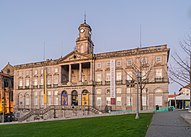Our website is made possible by displaying online advertisements to our visitors.
Please consider supporting us by disabling your ad blocker.
Porto
Porto | |
|---|---|
Municipality | |
Top to bottom, left to right: View of Ribeira district and Luís I bridge from Vila Nova de Gaia, Casa da Música concert hall, Porto City Hall, Palácio da Bolsa, Church of Saint Ildefonso | |
| Nickname(s): A Cidade Invicta ("The Undefeated City"), A Cidade da Virgem ("The City of the Virgin") | |
| Motto(s): Antiga, Mui Nobre, Sempre Leal e Invicta (Ancient, Most Noble, Always Loyal and Undefeated) | |
| Coordinates: 41°9′43.71″N 8°37′19.03″W / 41.1621417°N 8.6219528°W | |
| Country | |
| Region | Norte |
| Subregion | Grande Porto |
| District | Porto |
| Settlement | 275 BCE |
| Municipality | 868 |
| Civil parishes | 7 |
| Government | |
| • Type | LAU |
| • Body | Câmara Municipal |
| • Mayor | Rui Moreira |
| • Municipal Assembly Chair | Miguel Pereira Leite |
| Area | |
| • Municipality | 41.42 km2 (15.99 sq mi) |
| Elevation | 104 m (341 ft) |
| Population (2021) | |
| • Municipality | 231,962[1] |
| • Urban | 1,385,454[1] |
| • Metro | 1,737,395[1] |
| Time zone | UTC0 (WET) |
| • Summer (DST) | UTC+1 (WEST) |
| Postal Zone | 4000-286 Porto |
| Area code | (+351) 22[2] |
| Demonym | Portuense, Tripeiro (informal) |
| Patron Saint | Our Lady of Vendôme |
| Municipal Holidays | 24 June (São João) |
| Website | www |
| Geographic detail from CAOP (2010)[3] produced by Instituto Geográfico Português (IGP) | |
| Official name | Historic Centre of Oporto, Luís I Bridge and Monastery of Serra do Pilar |
| Criteria | iv |
| Reference | 755 |
| Inscription | 1996 (20th Session) |
Porto or Oporto[4] (Portuguese pronunciation: [ˈpoɾtu] (![]() listen)) is the second-largest city in Portugal after Lisbon and one of the major urban areas of the Iberian Peninsula.
listen)) is the second-largest city in Portugal after Lisbon and one of the major urban areas of the Iberian Peninsula.
The urban area of Porto, which extends beyond the administrative limits of the city, has a population of 2.4 million (2011) in an area of 389 km2(150 sq mi), making it the second-largest urban area in Portugal. It is recognized as a gamma level global city by the Globalization and World Cities (GaWC) Study Group, the only Portuguese city besides Lisbon to be recognised as a global city.
- ↑ 1.0 1.1 1.2 "Resultados Preliminares Censos 2021 INE". Retrieved 1 September 2021.
- ↑ "Portugal International Dialing Code". Archived from the original on 30 April 2010. Retrieved 12 September 2010.
- ↑ IGP, ed. (2010), Carta Administrativa Oficial de Portugal (in Portuguese), Lisbon, Portugal: Instituto Geográfico Português, archived from the original on 3 July 2014, retrieved 1 July 2011
- ↑ "Oporto". Lexico UK Dictionary. Oxford University Press. Retrieved 8 August 2019.
Previous Page Next Page











